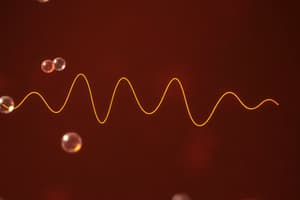Podcast
Questions and Answers
What occurs when all enzyme binding sites are saturated with substrate?
What occurs when all enzyme binding sites are saturated with substrate?
- The maximum velocity (Vmax) is reached (correct)
- The substrate concentration has no effect
- The reaction rate decreases
- The enzyme concentration increases
What happens to the reaction rate as substrate concentration increases, assuming enzyme concentration remains constant?
What happens to the reaction rate as substrate concentration increases, assuming enzyme concentration remains constant?
- The reaction rate decreases after a point
- The reaction rate is independent of substrate concentration
- The reaction rate initially increases and then levels off (correct)
- The reaction rate remains the same
At what temperature do most enzymes exhibit peak activity in humans?
At what temperature do most enzymes exhibit peak activity in humans?
- 50°C
- 25°C
- 37°C (correct)
- 60°C
What is the effect of high temperatures on enzyme activity?
What is the effect of high temperatures on enzyme activity?
How does pH affect enzyme activity?
How does pH affect enzyme activity?
What does the term Km represent in enzyme kinetics?
What does the term Km represent in enzyme kinetics?
Which of the following statements about substrate concentration and reaction rate is incorrect?
Which of the following statements about substrate concentration and reaction rate is incorrect?
What is the primary factor that causes variations in enzyme response to substrate concentration?
What is the primary factor that causes variations in enzyme response to substrate concentration?
Why does enzyme activity show a hyperbolic dependence on substrate concentration?
Why does enzyme activity show a hyperbolic dependence on substrate concentration?
What is the primary factor that determines enzyme specificity?
What is the primary factor that determines enzyme specificity?
What happens to the initial velocity of an enzyme-catalyzed reaction when the amount of enzyme is increased?
What happens to the initial velocity of an enzyme-catalyzed reaction when the amount of enzyme is increased?
What does enzyme kinetics primarily study?
What does enzyme kinetics primarily study?
Which of the following factors is NOT affecting enzyme activity?
Which of the following factors is NOT affecting enzyme activity?
How is the rate of reaction visually represented in enzyme kinetics?
How is the rate of reaction visually represented in enzyme kinetics?
What may cause the decline in the rate of an enzyme-catalyzed reaction over time?
What may cause the decline in the rate of an enzyme-catalyzed reaction over time?
What is the initial velocity (Vi) of an enzyme-catalyzed reaction?
What is the initial velocity (Vi) of an enzyme-catalyzed reaction?
What is the measurement unit for the velocity of an enzyme-catalyzed reaction?
What is the measurement unit for the velocity of an enzyme-catalyzed reaction?
Which type of interaction do enzymes primarily use to bind substrates?
Which type of interaction do enzymes primarily use to bind substrates?
What may occur if a product of an enzyme-catalyzed reaction inhibits the enzyme?
What may occur if a product of an enzyme-catalyzed reaction inhibits the enzyme?
What is the effect of competitive inhibitors on Km?
What is the effect of competitive inhibitors on Km?
Which of the following correctly describes noncompetitive inhibition?
Which of the following correctly describes noncompetitive inhibition?
What is a potential consequence of noncompetitive inhibitors?
What is a potential consequence of noncompetitive inhibitors?
What role does acetylcholinesterase play in the nervous system?
What role does acetylcholinesterase play in the nervous system?
How does penicillin exert its antibacterial effects?
How does penicillin exert its antibacterial effects?
Which of the following statements regarding enzyme inhibitors is true?
Which of the following statements regarding enzyme inhibitors is true?
What is a primary characteristic of enzymes?
What is a primary characteristic of enzymes?
What describes the active site of an enzyme?
What describes the active site of an enzyme?
Which model illustrates how an enzyme binds its substrate?
Which model illustrates how an enzyme binds its substrate?
What role do cofactors or coenzymes play in enzymatic reactions?
What role do cofactors or coenzymes play in enzymatic reactions?
Activation energy is defined as:
Activation energy is defined as:
How do enzymes affect the activation energy of a reaction?
How do enzymes affect the activation energy of a reaction?
What is a characteristic of the specificity of an enzyme?
What is a characteristic of the specificity of an enzyme?
What happens during the formation of an enzyme-substrate complex?
What happens during the formation of an enzyme-substrate complex?
In what way do enzymes affect biochemical pathways?
In what way do enzymes affect biochemical pathways?
What type of interactions primarily bond the substrate to the active site of an enzyme?
What type of interactions primarily bond the substrate to the active site of an enzyme?
What does a low Km value indicate about an enzyme?
What does a low Km value indicate about an enzyme?
In the context of enzyme kinetics, what does zero-order kinetics imply?
In the context of enzyme kinetics, what does zero-order kinetics imply?
What does the Lineweaver-Burk plot allow researchers to determine directly?
What does the Lineweaver-Burk plot allow researchers to determine directly?
What is true about competitive inhibitors?
What is true about competitive inhibitors?
What happens to the initial velocity (Vo) of an enzyme-catalyzed reaction if the enzyme concentration is halved?
What happens to the initial velocity (Vo) of an enzyme-catalyzed reaction if the enzyme concentration is halved?
In enzyme kinetics, what does a high Km value indicate?
In enzyme kinetics, what does a high Km value indicate?
What characterizes irreversible enzyme inhibitors?
What characterizes irreversible enzyme inhibitors?
Which part of the Lineweaver-Burk plot corresponds to Km?
Which part of the Lineweaver-Burk plot corresponds to Km?
What is the effect of increasing substrate concentration on a reaction inhibited by a competitive inhibitor?
What is the effect of increasing substrate concentration on a reaction inhibited by a competitive inhibitor?
Flashcards
Enzyme
Enzyme
A protein catalyst that speeds up chemical reactions without being consumed.
Substrate
Substrate
The molecule an enzyme acts upon.
Reaction Velocity
Reaction Velocity
The rate of product formation or substrate consumption.
Vmax
Vmax
Signup and view all the flashcards
Km
Km
Signup and view all the flashcards
Michaelis-Menten equation
Michaelis-Menten equation
Signup and view all the flashcards
Active site
Active site
Signup and view all the flashcards
Enzyme-substrate complex
Enzyme-substrate complex
Signup and view all the flashcards
Competitive inhibitor
Competitive inhibitor
Signup and view all the flashcards
Noncompetitive inhibitor
Noncompetitive inhibitor
Signup and view all the flashcards
Activation energy
Activation energy
Signup and view all the flashcards
Initial velocity
Initial velocity
Signup and view all the flashcards
Enzyme saturation
Enzyme saturation
Signup and view all the flashcards
Cofactor
Cofactor
Signup and view all the flashcards
Lineweaver-Burk plot
Lineweaver-Burk plot
Signup and view all the flashcards
Enzyme kinetics
Enzyme kinetics
Signup and view all the flashcards
Temperature
Temperature
Signup and view all the flashcards
pH
pH
Signup and view all the flashcards
Reversible inhibitor
Reversible inhibitor
Signup and view all the flashcards
Irreversible inhibitor
Irreversible inhibitor
Signup and view all the flashcards
Enzyme specificity
Enzyme specificity
Signup and view all the flashcards
Study Notes
Concentration of Substrate and Reaction Rate
- Initial velocity of a reaction is directly proportional to substrate concentration until reaching maximum velocity (Vmax).
- Beyond Vmax, further substrate increases do not affect reaction velocity when enzyme concentration remains constant.
- Reaction rate is the amount of substrate converted to product per unit time, commonly expressed as micromoles of product formed per minute.
- Reaction rate increases with substrate concentration until all enzyme binding sites are saturated.
Factors Affecting Enzyme Action
- Enzyme responses vary with substrate concentration, temperature, and pH levels.
- At low temperatures, enzyme activity is minimal; activity increases with temperature until an optimal peak is reached (typically around 37°C in humans).
- High temperatures can lead to denaturation of enzymes, reducing reaction velocity.
Enzyme Characteristics
- Enzymes are catalysts that accelerate reaction rates without being consumed; they are proteins with high specificity.
- They affect the rate of reaction but not the overall equilibrium.
- Enzymes can require cofactors or coenzymes and participate in various biochemical pathways.
Active Site and Mechanism of Action
- The active site is the enzyme region that binds substrates, forming an enzyme-substrate complex through weak non-covalent interactions.
- Activation energy is the energy needed for substrates to reach the transition state; enzymes lower this energy barrier.
- Specificity of enzymes is determined by both substrate and enzyme functional groups and their spatial arrangement.
Enzyme Kinetics
- Enzyme kinetics studies reaction velocity, defined as the rate of product formation or substrate consumption over time.
- Initial velocity (Vi) is measured during the first portion of the reaction, correlating product increase with time.
- Factors affecting enzyme activity include enzyme concentration, with initial velocity proportionate to enzyme amount, independent of substrate concentration parameters such as Km.
Michaelis-Menten Kinetics
- The relation between reaction velocity (V) and substrate concentration ([S]) can be described by the Michaelis-Menten equation.
- When [S] exceeds Km, the reaction rate reaches Vmax, indicating a zero-order reaction.
- The Lineweaver-Burk Plot provides a linear transformation of the Michaelis-Menten equation, allowing easy determination of Vmax and Km from graph intercepts.
Enzyme Inhibition
- Enzyme inhibitors reduce reaction velocity and catalytic activity; can be reversible or irreversible.
- Competitive inhibitors resemble substrate and compete for the active site, increasing the apparent Km but not affecting Vmax.
- Noncompetitive inhibitors bind at a site separate from the substrate, reducing Vmax without affecting Km.
Enzyme Inhibitors in Medicine
- Sarin is a nerve gas that inhibits acetylcholinesterase, preventing acetylcholine hydrolysis, leading to excessive neuronal stimulation and severe physiological effects.
- Penicillin acts as an antibiotic by inhibiting bacterial peptidoglycan synthesis, preventing cell wall formation and bacterial growth.
Studying That Suits You
Use AI to generate personalized quizzes and flashcards to suit your learning preferences.



